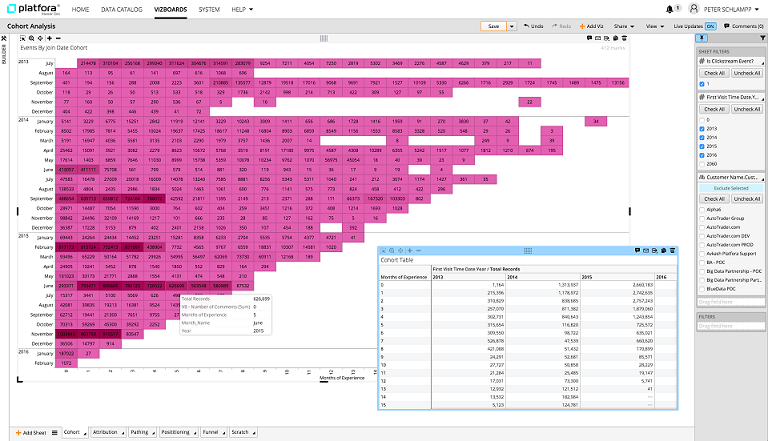Bridging the Big Data Gap in Big Pharma with Healthcare Analytics
 In this special guest feature, Brian Irwin, VP of Strategy at SHYFT Analytics, takes a look at the three market dynamics driving life sciences organizations to evaluate new data analytics strategies and technologies as they transform into value-based care delivery models. He leads strategic account development and partnership initiatives while serving as a key strategist for the company. SHYFT Analytics is a leading cloud analytics company within life sciences. The company plays an integral role as the industry continues to undergo dramatic transformation to deliver more personalized and value-based medicine. Brian has over 12 years of experience in a variety of sales and leadership roles within the life sciences industry. Areas of impact and focus have included organizational leadership, executive account management, and strategic enterprise development. Most recently, Brian served as the President and Managing Director at Informa Training Partners, a company focused on Clinical and Managed Market training solutions devoted exclusively to pharmaceutical, biotech, and med device companies. Additionally, Brian spent 9 years with Takeda Pharmaceuticals N.A. in positions of increasing responsibility, leadership, and organizational development. Brian holds a BA in Biology and Natural Sciences from St. Anselm College.
In this special guest feature, Brian Irwin, VP of Strategy at SHYFT Analytics, takes a look at the three market dynamics driving life sciences organizations to evaluate new data analytics strategies and technologies as they transform into value-based care delivery models. He leads strategic account development and partnership initiatives while serving as a key strategist for the company. SHYFT Analytics is a leading cloud analytics company within life sciences. The company plays an integral role as the industry continues to undergo dramatic transformation to deliver more personalized and value-based medicine. Brian has over 12 years of experience in a variety of sales and leadership roles within the life sciences industry. Areas of impact and focus have included organizational leadership, executive account management, and strategic enterprise development. Most recently, Brian served as the President and Managing Director at Informa Training Partners, a company focused on Clinical and Managed Market training solutions devoted exclusively to pharmaceutical, biotech, and med device companies. Additionally, Brian spent 9 years with Takeda Pharmaceuticals N.A. in positions of increasing responsibility, leadership, and organizational development. Brian holds a BA in Biology and Natural Sciences from St. Anselm College.
Life sciences organizations recognize that Big Data is both an opportunity and a challenge for their entire industry. However, the strategies and systems, processes, and platforms in place today are not successful and cannot contend with the demands of a rapidly evolving healthcare industry. As total spending on medicines globally reaches the $1 trillion level annually and with no end in sight to rising costs, there is tremendous pressure across the healthcare ecosystem to improve outcomes and prove value. Core to making healthcare more efficient, measureable, and patient-centric is the ability to integrate vast data resources available across this ecosystem and translate them into meaningful, actionable insights.
The demand for timely and improved use of these data creates pressure across the various channels of healthcare, leaving manufacturers, payers, and provider groups particularly vulnerable to the big data deluge. Tasked with making sense of the exponential volumes of patient-level clinical and financial data, these organizations must also capitalize on opportunities to inform both clinical and commercial strategies simultaneously. A demand for data access across the enterprise, a changing competitive landscape tied to intense cost pressures, and the rapid influx of Real World Evidence (RWE) data is forcing the hand of every healthcare entity. Their vast network of data silos – historically housed in rigid, brittle, inaccessible systems – are no longer fit to serve as the backbone of operations in an increasingly dynamic and often unpredictable marketplace.
Let’s take a closer look at the three market dynamics driving life sciences organizations to evaluate new data analytics strategies and technologies as they transform into value-based care delivery models.
1 — Data Demands across the Enterprise
The rapid proliferation of technology and the overall shift towards patient engagement has generated an unprecedented amount of clinical and commercial data. However, overburdened internal resources have their hands tied with even gaining access to these data as well as archaic reporting processes. Historically, getting data out of these silos and into the hands of decision makers across the different facets of a company’s operations took weeks, even months. To make matters worse the ‘reports’ that were developed and delivered for review were often incomplete, lacking the right data or the right detail to truly inform business decisions. Executives had two choices: Accept the information as they were or ask for modifications and wait another month for the final result.
Today it is clear that pharmaceutical companies no longer have the luxury of time; waiting for insights, which are subpar at best and inaccurate at worst, risks any potential first mover advantage that could be gained. Without a faster, more effective way to manage data across the enterprise, life sciences companies cannot garner insights quickly enough to stay competitive.
2 — Cost Reductions and Increased Commercialization Costs
Life sciences companies are undergoing a massive shift in the way information is gathered, used and leveraged to drive successful outcomes in all areas of their ecosystem. At the same time, many are constrained by tighter payer controls and increased commercialization costs. According to an IMS Institute IT survey, over $35 billion in cost reductions are needed through 2017 in order for large pharmaceutical manufacturers to maintain their current levels of research and development activities as well as their operating margin levels. The same study found that almost half of survey respondents, 45 percent, confirmed they are planning cuts of more than 10 percent over the next three years. The question becomes, “how can we conduct these research activities, particularly observational research, faster and cheaper than its done today? Companies have invested heavily in all of the data they need, but lack the technology and applications required to achieve these goals.
These cost pressures sit in paradox to the revenue opportunity available from the industry data explosion; life sciences companies are struggling to find the balance between cost reductions and investment in innovations. All recognize that if they cannot take advantage of the data in front of them their competitor certainly will… and will take their market share too.
Transforming data into insights through proven analytics can support the industry’s increasing need for real-world and outcomes-based insights. By rethinking the silos that permeate their businesses they can improve the volume and value of research activities shorten cycle times across all lifecycle phases, strengthen analytical competence and drive rapid change and market differentiation.
3 — Real World Evidence will Drive Enterprise Success Factors
RWE includes elements associated with the delivery of care – electronic medical records, claims information, patient surveys, clinical trial effectiveness, treatment preferences, even physician utilization patterns. Until recently no one has been able to crack the code on RWE success– conservative market estimates suggest big pharma spends $20 million dollars on an average annually on RWE, but they are still no closer to fully understanding the real world impact of pharmacologic and non-pharmacologic treatment on patients and healthcare systems.
The typical approach to RWE – a myriad of siloed databases, services-dependent, with access restructured to just a handful of “power users” – has shown to be vastly ineffective. It simply cannot address the need to quickly access, analyze, and deliver insights from real-world data for broad use across the organization.
As pharmaceutical companies continue to invest, create, and collect real-world evidence data, each of them must be able to turn that information into actionable insights as they seek to impact treatment options, reduce costs, and improve patient outcomes. By translating RWE data into patient-centric intelligence and analytics for use across the clinical – commercial continuum, the impact of real world data can quickly go from basic theory to pervasive practice and finally deliver upon its promise to transform treatment strategies and the health of patients everywhere.
Cloud-based analytics can bridge the Big Data gap. Such solutions have the capability to translate data into patient-centric intelligence for use across the enterprise. The result is an improvement to both the volume and value of research activities, shorter cycle times across all lifecycle phases, and stronger, more complete analytical competence to drive rapid change and market differentiation. By enabling these organizations to quickly access, analyze, and deliver meaningful insights for broad use, they can deliver a better understanding of unmet patient need, create more targeted and streamlined product development, and contribute to the overall elevation of quality healthcare.
Sign up for the free insideBIGDATA newsletter.
Source: insideBigData




